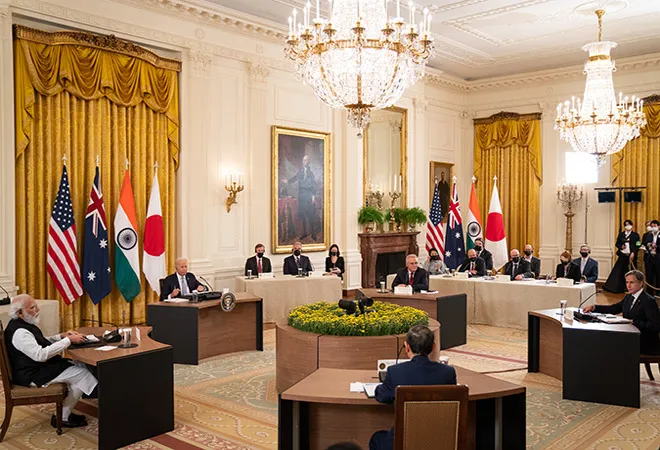-
CENTRES
Progammes & Centres
Location
As new geopolitical and geo-economic realities emerge in the Indo-Pacific, India is now a critical node in the emerging network of variable geometries in the region. There are important opportunities in the evolving dynamic for New Delhi, as new alliances are crafted and new goals enunciated.

Expectations ran high across the world as the keenly anticipated Quad Summit between India, Japan, Australia and the United States kicked off in Washington. This first in person summit, following closely on the heels of a virtual meeting just six months ago, drove home the speed of geopolitical shifts currently underway. From maintaining a Free and Open Indo-Pacific to combating climate change, the four partner countries have turned to the Quad as the forum of choice to address mutual concerns.
As America ended its long war in Afghanistan, the world watched uneasily as chaos unfolded following the Taliban’s takeover. Much has been made about the possibility of America's abdication of international responsibility. This was laid to rest through a forceful joint statement that articulated the Quad's commitment to containing terrorism and securing human rights in Afghanistan. The acknowledgement from partner nations that their "shared futures will be written in the Indo-Pacific" manifested in a pledge to "redouble efforts to ensure that the Quad is a force for regional peace, stability, security, and prosperity". Add this to the announcement of the AUKUS submarine pact and one is left with the conclusion that the Biden Administration has chosen to reimagine its engagement with the region. It is as clear a statement of intent as any: America will remain a key player in Asia.
From maintaining a Free and Open Indo-Pacific to combating climate change, the four partner countries have turned to the Quad as the forum of choice to address mutual concerns.
Another welcome development was the grouping's reaffirmed desire to work with like-minded partners. While paying traditional homage to concept like "ASEAN centrality", the four powers also singled out the EU's new Indo-Pacific Cooperation strategy for support. This new document broke new ground by directly calling out Chinese actions in the South China Sea and human rights violations in Xinjiang. What's more, the new strategy calls for expanded EU partnerships on security, technology and economic strategy with a range of new partners like India and South Korea. With this convergence in interests, expect more Quad-EU cooperation in the region.
Now, onto the policies. Taking cognizance of the still raging COVID-19 pandemic, Australia and Japan in particular committed large sums towards ensuring vaccine supplies for Southeast Asia and the Pacific. The four powers also vowed actions on climate and proposed both a Green Shipping Network, which seeks to decarbonise global shipping routes and a Clean Hydrogen Partnership that aims to boost Indo-Pacific trade in this revolutionary new green technology.
While paying traditional homage to concept like "ASEAN centrality", the four powers also singled out the EU's new Indo-Pacific Cooperation strategy for support.
The Quad also announced the formation of a Quad Infrastructure Coordination Group to better channel the grouping’s infrastructure investments in developing countries. This development signals that the Quad has resolved to end the hand-wringing and moral posturing that has thus far characterised the response to China's Belt and Road Initiative. By establishing this coordination mechanism and aligning it with other initiatives like the Blue Dot Network, the Quad has signalled that it is finally ready to put in the investment and political capital required to compete against China’s behemoth infrastructure development initiatives.
Further, battles over the future of the global technology landscape between the US and China have dominated headlines for months now. The newly released Quad Statement of Principles promises to shape an “open, high standard innovation” ecosystem in a direct challenge to more restrictive competitors. By putting together sectoral groups to formulate technological standards, the Quad hopes to develop key standards, roll them out globally and establish a major competitive advantage vis-a-vis more hostile players like China that will have little choice but to accept a Quad-designed technology architecture. The grouping also moved quickly to secure supply lines for key global technologies through the Semiconductor Supply Chain Initiative. In making such a clear power play to jointly develop and operationalise critical technologies like semiconductors, 5G and Artificial Intelligence, the Quad has thrown down the gauntlet in front of China. With such a clear statement of intent, the future of global technology competition will likely heat up from here on out.
The four powers also vowed actions on climate and proposed both a Green Shipping Network, which seeks to decarbonise global shipping routes and a Clean Hydrogen Partnership that aims to boost Indo-Pacific trade in this revolutionary new green technology.
An escalation of rivalries also seems inevitable in cyber and space technologies as the Quad announced two new working groups to tackle these sectors. While the elevated global threat environment surrounding cyber security, due in no small part to Russian and Chinese cyberattacks on key infrastructure, is driving Quad cooperation, it is hard to resist the conclusion that China’s rapidly expanding and military-driven space force is the main force behind the Quad’s decision to jointly develop new space technologies.
However, the Quad has challenges to overcome. The much-hyped Quad Vaccine Partnership has supplied only 79 million doses of its ambitious 1.2 billion dose target. While much of this shortfall can be chalked up to the disruptions caused by India’s devastating second COVID wave, the Quad must tread carefully. If it now wishes to avoid a reputation for high minded diplomatic talk but little action, it must focus its attention on delivering on the multifarious promises made. The outcome of the summit will give little comfort to neutral powers in ASEAN that wish desperately to steer clear of great power competition. Given the unmistakably China-focused nature of many policies announced in the summit, competition now seems to be the order of the day and the four Quad powers must handle their reluctant neighbours deftly.
The outcome of the summit will give little comfort to neutral powers in ASEAN that wish desperately to steer clear of great power competition.
India, in particular, has had a successful sojourn in Washington. As new geopolitical and geo economic realities emerge in the Indo-Pacific, India is now a critical node in the emerging network of variable geometries in the region. There are important opportunities in the evolving dynamic for New Delhi as new alliances are crafted and new goals enunciated. Bold decision making is the need of the hour.
This commentary originally appeared in The Economic Times.
The views expressed above belong to the author(s). ORF research and analyses now available on Telegram! Click here to access our curated content — blogs, longforms and interviews.

Professor Harsh V. Pant is Vice President – Studies and Foreign Policy at Observer Research Foundation, New Delhi. He is a Professor of International Relations ...
Read More +
Shashank Mattoo was a Junior Fellow with the ORFs Strategic Studies Program. His research focuses on North-East Asian security and foreign policy.
Read More +